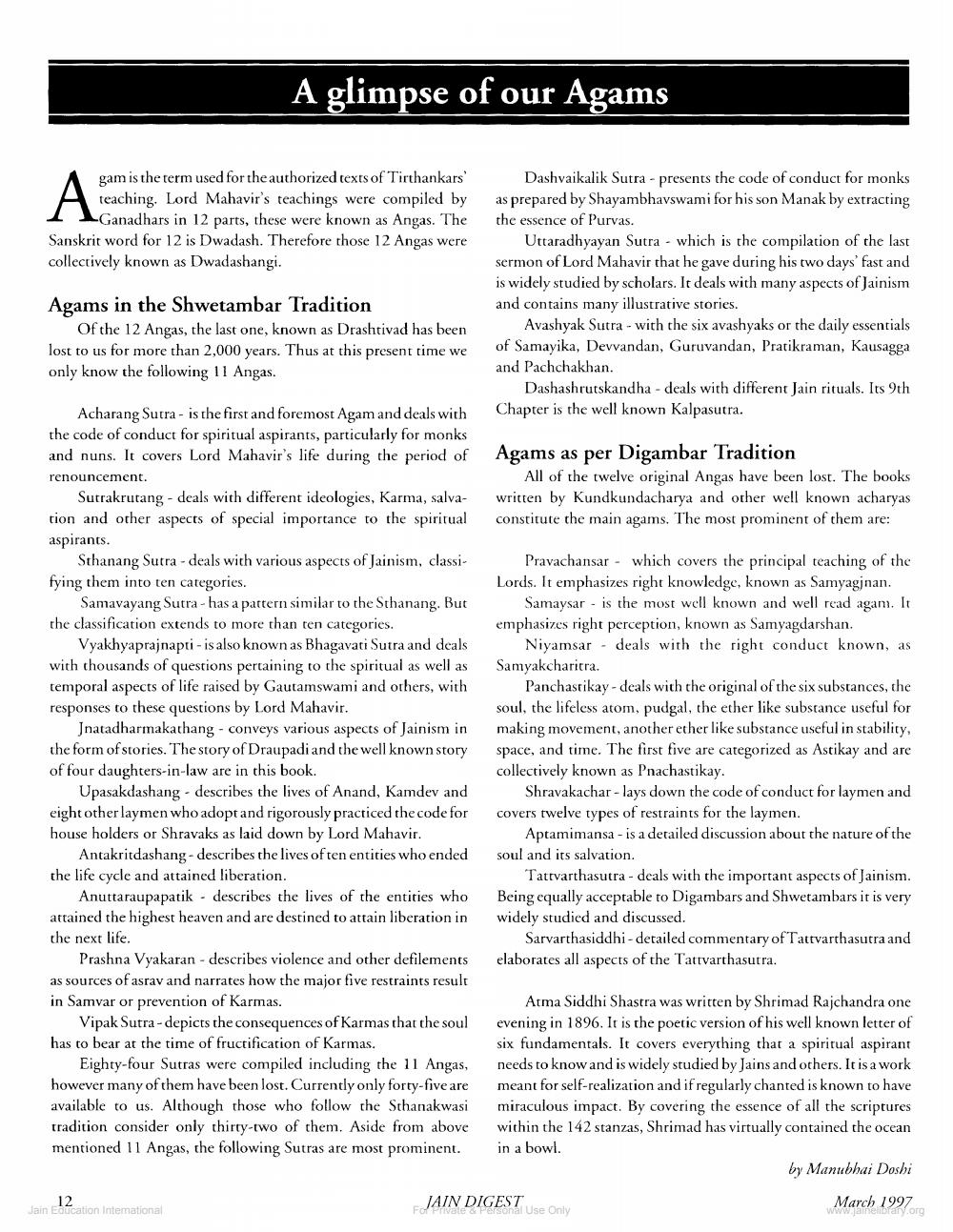________________
A glimpse of our Agams
A
gam is the term used for the authorized texts of Tirthankars' teaching. Lord Mahavir's teachings were compiled by Ganadhars in 12 parts, these were known as Angas. The Sanskrit word for 12 is Dwadash. Therefore those 12 Angas were collectively known as Dwadashangi.
Agams in the Shwetambar Tradition
Of the 12 Angas, the last one, known as Drashtivad has been lost to us for more than 2,000 years. Thus at this present time we only know the following 11 Angas.
Acharang Sutra - is the first and foremost Agam and deals with the code of conduct for spiritual aspirants, particularly for monks and nuns. It covers Lord Mahavir's life during the period of
renouncement.
Sutrakrutang - deals with different ideologies, Karma, salvation and other aspects of special importance to the spiritual aspirants.
Sthanang Sutra - deals with various aspects of Jainism, classifying them into ten categories.
Samavayang Sutra - has a pattern similar to the Sthanang. But the classification extends to more than ten categories.
Vyakhyaprajnapti - is also known as Bhagavati Sutra and deals with thousands of questions pertaining to the spiritual as well as temporal aspects of life raised by Gautamswami and others, with responses to these questions by Lord Mahavir.
Jnatadharmakathang - conveys various aspects of Jainism in the form of stories. The story of Draupadi and the well known story of four daughters-in-law are in this book.
Upasakdashang - describes the lives of Anand, Kamdev and eight other laymen who adopt and rigorously practiced the code for house holders or Shravaks as laid down by Lord Mahavir.
Antakritdashang - describes the lives of ten entities who ended the life cycle and attained liberation.
Anuttaraupapatik - describes the lives of the entities who attained the highest heaven and are destined to attain liberation in the next life.
Prashna Vyakaran - describes violence and other defilements as sources of asrav and narrates how the major five restraints result in Samvar or prevention of Karmas.
Vipak Sutra - depicts the consequences of Karmas that the soul has to bear at the time of fructification of Karmas.
Eighty-four Sutras were compiled including the 11 Angas, however many of them have been lost. Currently only forty-five are available to us. Although those who follow the Sthanakwasi tradition consider only thirty-two of them. Aside from above mentioned 11 Angas, the following Sutras are most prominent.
12
Jain Education International
Dashvaikalik Sutra - presents the code of conduct for monks as prepared by Shayambhavswami for his son Manak by extracting the essence of Purvas.
Uttaradhyayan Sutra - which is the compilation of the last sermon of Lord Mahavir that he gave during his two days' fast and is widely studied by scholars. It deals with many aspects of Jainism and contains many illustrative stories.
Avashyak Sutra - with the six avashyaks or the daily essentials of Samayika, Devvandan, Guruvandan, Pratikraman, Kausagga and Pachchakhan.
Dashashrutskandha - deals with different Jain rituals. Its 9th Chapter is the well known Kalpasutra.
Agams as per Digambar Tradition
All of the twelve original Angas have been lost. The books written by Kundkundacharya and other well known acharyas constitute the main agams. The most prominent of them are:
Pravachansar - which covers the principal teaching of the Lords. It emphasizes right knowledge, known as Samyaginan.
Samaysar - is the most well known and well read agam. It emphasizes right perception, known as Samyagdarshan.
Niyamsar deals with the right conduct known, as Samyakcharitra.
Panchastikay - deals with the original of the six substances, the soul, the lifeless atom, pudgal, the ether like substance useful for making movement, another ether like substance useful in stability, space, and time. The first five are categorized as Astikay and are collectively known as Pnachastikay.
Shravakachar - lays down the code of conduct for laymen and covers twelve types of restraints for the laymen.
Aptamimansa - is a detailed discussion about the nature of the soul and its salvation.
Tattvarthasutra - deals with the important aspects of Jainism. Being equally acceptable to Digambars and Shwetambars it is very widely studied and discussed.
Sarvarthasiddhi- detailed commentary of Tattvarthasutra and elaborates all aspects of the Tattvarthasutra.
Atma Siddhi Shastra was written by Shrimad Rajchandra one evening in 1896. It is the poetic version of his well known letter of six fundamentals. It covers everything that a spiritual aspirant needs to know and is widely studied by Jains and others. It is a work meant for self-realization and if regularly chanted is known to have miraculous impact. By covering the essence of all the scriptures within the 142 stanzas, Shrimad has virtually contained the ocean in a bowl.
JAIN DIGEST
For Private & Personal Use Only
by Manubhai Doshi
March 1997 www.jainelibrary.org




